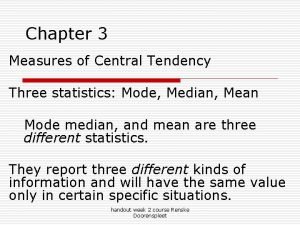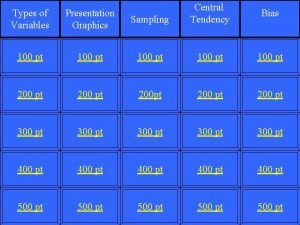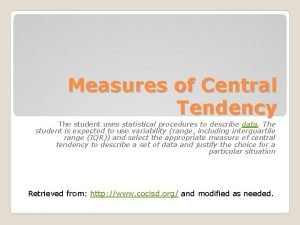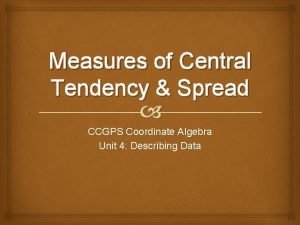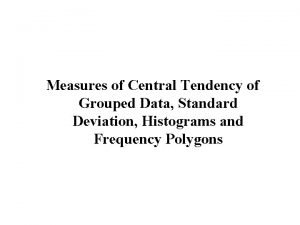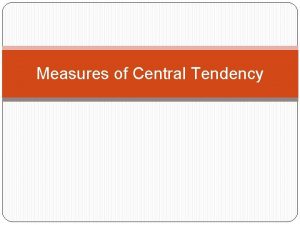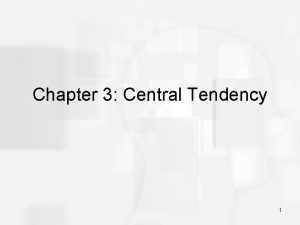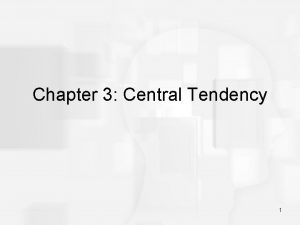Chapter 4 Central Tendency How do we quantify








- Slides: 8

Chapter 4: Central Tendency How do we quantify the ‘middle’ of a distribution of numbers? Three ways: The mode, median and the mean Mode (Mo): The score that occurs with the greatest frequency Example: the mode of this sample of 7 numbers: 5, 3, 1, 6, 2, 8, 3 is 3. The modal color of M&M’s is brown. Note that the mode is appropriate for nominal scores

Median (Mdn): The value that divides the distribution into halves. Same as P 50 We calculate the median by calculating P 50. Actually, calculating the median is easy: If there an odd number of scores, then the median is the middle number. If there an even number, then the median is the average of the middle two. Example: Find the median of this sample of 7 numbers: 5, 3, 1, 6, 2, 8, 3 Reorder: 1, 2, 3, 3, 5, 6, 8. The median is 3.

mean: the sum of all scores divided by the total number of scores. Using mathematical symbols: mx: mean of a population of scores (pronounced ‘mu of x’) : mean of a sample of scores (pronounced ‘x bar’) n: the number of scores in a sample N: the number of scores in a population Xi: the ith number in a sample’ S: means to add (sigma) The sample mean is: The population mean is: Which we shorten to:

Example: find the mean of this sample of 7 numbers: 5, 3, 1, 6, 2, 8, 3 X 1 = 5, X 2 = 3, X 3 = 1, X 4 = 6, X 5 = 2, X 6 = 8, X 7 = 3

Fun facts about the mean -The mean is affected by all numbers in the sample (unlike the mode or median) -The mean is the value that makes From the example above: -Multiplying all scores by a number multiplies the mean by that same number -Adding a number to all scores adds the same number to the mean. -The mean is the ‘balance’ point of a distribution. 1 2 3 4 5 6 7 8

More stuff about the median and mean The median is not sensitive to outliers: Median of 1, 2, 4, 5, and 10000 is 4. The mean is 2002. 4 For a skewed distribution, the mean is pulled toward the tail compared to the median Median=705 Mean=683. 9 40 35 Frequency 30 25 20 15 10 5 0 325 375 425 475 525 575 625 GRE quant scores 675 725 If a distribution is ‘symmetric’ (like a normal distribution), then the mean and median are the same. 775

Medians are usually reported for income because of the positive skew in the distribution Bottom 98% of US household income (2005) http: //www. visualizingeconomics. com/wp-content/uploads/2005_income_distribution. gif

Reaction times are a classic example of a skewed distribution in psychology 200 Mean: 160. 2 Median: 154. 2 180 160 140 Frequency 120 100 80 60 40 20 0 50 100 150 200 Reaction time (msec) 250 300 350


